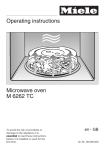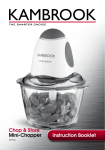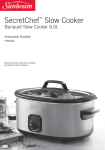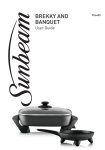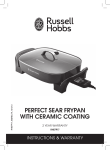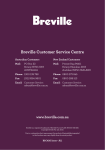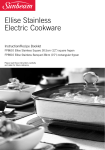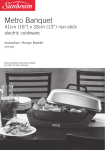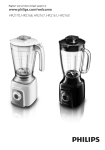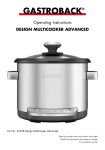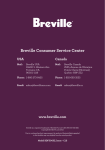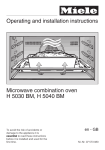Download Kambrook KPR600 User's Manual
Transcript
Kambrook - Australia Building 2, Port Air Industrial Estate 1A Hale Street Botany NSW 2019 Australia Customer Service Line 1300 139 798 Customer Service Fax 1800 621 337 www.kambrook.com.au Kambrook - New Zealand Private Bag 94411 Botany, Manukau Auckland 2163 New Zealand Customer Service Line/ Spare Parts 0800 273 845 Customer Service Fax 0800 288 513 www.kambrook.co.nz Due to continual improvement in design or otherwise, the product you purchase may differ slightly from the illustration in this book. Issue E12 Pressure Express Pressure Cooker KPR600 Instruction Booklet Important Please retain your instruction book for future use. In the event that you need some assistance with your Kambrook appliance, please contact our Customer Service Department on 1300 139 798 (Australia) or 0800 273 845 (New Zealand). Alternatively, visit us on our website at www.kambrook.com.au or www.kambrook.co.nz Contents Kambrook Recommends Safety First p4 Your Kambrook Pressure Express p7 Using Your Kambrook Pressure Express p8 Pressure Express Cooking Guide p15 Trouble Shooting Guide p20 The Do’s & Don’ts of Pressure Cooking p21 Care, Cleaning and Storage p22 Handy Hits for Pressure Cooking p25 Recipesp26 Kambrook Recommends Safety First IMPORTANT: Please retain your instruction book for future use. At Kambrook, we believe that safe performance is the first priority in any consumer product, so that you, our valued customer can confidently use and trust our products. We ask that any electrical appliance that you use be operated in a sensible fashion with due care and attention placed on the following important operating instructions. Important Safeguards For Your Kambrook Pressure Express Pressure Cooker • Carefully read all instructions before operating the pressure cooker for the first time and save for future reference. • Remove and safely discard any packaging material and promotional label before using the pressure cooker for the first time. • To eliminate a choking hazard for young children, remove and safely discard the protective cover fitted to the power plug of this pressure cooker. • Do not place the pressure cooker near the edge of a bench or table during operation. Ensure that the surface is level, clean and free of water and other substances. • Position the pressure cooker so that the steam vent/pressure relief valve is directed away from yourself. Lift and remove the lid carefully to avoid scalding from escaping steam. • Do not operate the pressure cooker on a sink drain board. • Do not place your face or any other body part over the appliance whilst in use as the steam can cause serious burns. • Always ensure pressure cooker is properly assembled before use. Follow the instructions provided in this book. • Do not touch hot surfaces. Use handles on the sides of the appliance and on lid for lifting and carrying the pressure cooker. 4 • Always insert the connector end of the power cord into the appliance inlet before inserting power plug into power outlet and switching on appliance. Ensure the appliance inlet is completely dry before inserting the connector end of the power cord. • This pressure cooker cooks under pressure. Improper use may result in injury. • When using this pressure cooker, ensure the lid is properly assembled and locked into position before use. • Do not touch hot surfaces, use oven mitts to remove the lid and removable cooking bowl. Lift and remove the lid carefully and away from yourself to avoid scalding from escaping steam. • Use the removable cooking bowl supplied with the pressure cooker only. Do not use any other bowl inside the pressure cooker housing. • Do not use a damaged or dented removable cooking bowl. If damaged or dented, replace bowl before using. • Never plug in or switch on the pressure cooker without having the removable cooking bowl placed inside the pressure cooker housing. • Do not place food or liquid in the pressure cooker housing. Only the removable cooking bowl is designed to contain food or liquid. • Never operate the pressure cooker without food and liquid in the removable cooking bowl. Ensure that the level of food and liquid inside the removable cooking bowl is not below ‘2’ level mark before cooking commences. Always follow the maximum and minimum quantities of liquid stated in instructions and recipes. • Always operate the pressure cooker on a stable and heat resistant surface. • Do not use chemicals, steel wool, metal scouring pad or abrasive cleaners to clean the outside of the pressure cooker housing or cooking bowl as these can damaged the housing or the coating of the cooking bowl. • Do not place anything, other than lid, on top of pressure cooker when assembled, when in use and when stored. • Do not allow water from the lid to drip into the pressure cooker housing, only into the removable cooking bowl. • Always have the lid placed correctly into position on the pressure cooker throughout operation of the pressure cooker unless states in the recipe to have it removed. • Do not leave the pressure cooker unattended when in use. • Do not place anything on top of the lid when assembled, when in use and when stored. • Extreme caution must be used when pressure cooker contains hot food and liquids and/or is under pressure. Improper use may result in injury. When using this appliance, make sure the lid is properly locked and aligned before operating. • Ensure the removable cooking bowl is correctly positioned in the pressure cooker base before you commence cooking. • Before placing removable cooking bowl into stainless steel base ensure base of bowl and base of pressure cooker is dry by wiping with a dry soft cloth. • Do not use the pressure cooker for anything other than its intended use. Do not attempt to operate pressure cooker by any method other than those described in this instruction book. • Some foods to avoid when pressure cooking are; apple sauce, cranberries, pearl barley, oatmeal and other cereals, potatoes, noodles and pasta, and rhubarb; these foods can foam, froth and splatter and clog the pressure regulator/release valve and pressure indicator valve. • Removable cooking bowl can be extremely heavy when full of ingredients, care should be taken when lifting from pressure cooker base. • Do not use the lid handle to carry appliance when in use and after use. • Always ensure that the removable cooking bowl has cooled sufficiently before handling and use oven mitts when removing the removable cooking bowl from the stainless steel housing. • Do not adjust the “pressure regulator/release valve” whilst in use. • Use only recommended “Steam Release” to depressurise cooker after use. • Do not exceed maximum fill level. Some foods expand during pressure cooking such as rice and legumes, do not fill removable cooking pan over ½ full. Over filling may cause a risk of clogging the pressure regulator/release valve/release valve and pressure indicator valve. It may also lead to the development of excess pressure. • Do not use abrasive cleaners, steel wool, or metal scouring pads as these can damage the non-stick surface. • The temperature if accessible surfaces will be high when the pressure cooker is operating and for some time after use. • Do not place the removable cooking bowl when hot on any surface that may be affected by heat. • Avoid sudden temperature changes. Do not place frozen or very cold foods into the removable cooking bowl when it is hot. Do not place hot removable cooking bowl into cold water. • Do not use the removable cooking bowl for food storage. The removable cooking bowl is not designed for storing food in the freezer. • Ensure pressure cooker is fully cooled before storing power cord inside the removable cooking bowl. • To prevent scratching the non-stick surface of the removable cooking bowl, always use wooded or plastic utensils. • Always position steam vent on lid away from yourself to avoid scalding from escaping steam. • Suggested cooking times in this instruction book are approximate. Cooking times can vary depending on ingredients and quantities in recipes. • Do not attempt to open the pressure cooker lid after pressure cooking until all internal pressure has been released and is slightly cooled. If the lid will not turn to unlock, this indicates that appliance is still under pressure – do not force the lid open. Any pressure remaining can be hazardous. See operating instructions for “steam release” directions in this instruction book. • Always check pressure regulator/release valve and pressure indicator valve for clogging before use and clean if necessary. Check to make sure the pressure indicator rod moves freely from under the lid. • The appliance connector must be removed before the pressure cooker is cleaned and that the appliance inlet must be dried before the pressure cooker is used again. • Do not immerse pressure cooker housing/base, power cord or plug in water or any other liquid. 5 • Do not move the pressure cooker when in use. • Keep the pressure cooker clear of walls, curtains and other heat or steam sensitive materials. • Use the pressure release/regulator valve to release steam pressure. • Never use the removable cooking bowl to sauté ingredients on a ceramic, electric or gas stove. Ensure that the safety locking lid is properly aligned, locked and closed before operating (see instructions on page 8). • The pressure cooker is not intended to be operated by means of an external timer or separate remote control system. • Always ensure that the power is off at the power outlet and remove power plug from the power outlet before attempting to move the appliance before cleaning and storing. • Keep the pressure cooker clean. Follow the cleaning instructions provided in the book (see page 22). Important Safeguards For All Electrical Appliances • Fully unwind the power cord before use. • Connect only to 230V or 240V power outlet. • D o not let the power cord hang over the edge of a bench or table, touch hot surfaces or become knotted. • T o protect against electric shock, do not immerse the power cord, power plug or appliance in water or any other liquid, unless it is recommended in the cleaning instructions. • T he appliance is not intended for use by persons (including children) with reduced physical, sensory or mental capabilities, or lack of experience and knowledge, unless they have been given supervision or instruction concerning use of the appliance, by a person responsible for their safety. • T he installation of a residual current device (safety switch) is recommended to provide additional safety protection when using electrical appliances. It is advisable that a safety switch with a rated residual operating current not exceeding 30mA be installed in the electrical circuit supplying the appliance. See your electrician for professional advice. • A lways turn the appliance to the OFF position, switch off at the power outlet and unplug at the power outlet when the appliance is not in use. • B efore cleaning, always turn the appliance to the OFF position, switch off at the power outlet, unplug at the power outlet and remove the power cord, if detachable, from the appliance and allow all parts to cool. • C hildren should be supervised to ensure that they do not play with the appliance. • D o not place this appliance on or near a heat source, such as hot plate, oven or heaters. • It is recommended to inspect the appliance regularly. Do not use the appliance if the power supply cord, plug, connector or appliance becomes damaged in anyway. Return the entire appliance to the nearest authorised Kambrook Service Centre for examination and/or repair. • P osition the appliance at a minimum distance of 20cm away from walls, curtains and other heat or steam sensitive materials and provide adequate space above and on all sides for air circulation. • A ny maintenance other than cleaning should be performed at an authorised Kambrook Service Centre. • T his appliance is for household use only. Do not use this appliance for other than its intended use. Do not use in moving vehicles or boats. Do not use outdoors. Misuse may cause injury. 6 Your Kambrook Pressure Express 1. Cool touch lid handle 2. Pressure regulator/release valve controls the rate at which steam vents from the Pressure Express and degree of the pressure inside the Pressure Express 3. Pressure release venting position to release the pressure inside the pressure cooker 4. Safety locking lid – can not be opened during pressure cooking 5. 6 litre non-stick removable cooking bowl 6. Selection control dial allows you to select from settings 1 to 6, as well as the Sauté function 7. Cool touch handles 8. Brushed stainless steel housing Not Shown • • • • • • Stainless steel trivet raises food out of the liquid when pressure cooking Removable power cord Rice measuring cup Heat resistant serving spoon Heat resistant soup serving ladle Pressure safety release valve cover 7 Using Your Kambrook Pressure Express Before First Use Remove and safely discard any packaging material and promotional stickers before using the Pressure Express for the first time. To eliminate a choking hazard for young children, remove and safely discard the protective cover fitted to the removable power cord of this appliance. 1. Make sure that the power outlet is switched off and that the removable power cord is unplugged from the power outlet and the Pressure Express. 2. Remove the safety locking lid by taking hold of the handle, turning it clockwise from the locked position to the unlock/ align position and lift the lid up and off the appliance (see Fig. 1). Fig. 2 4. Return the dry and clean silicone rubber gasket securely to the gasket holder (see Fig. 3). Fig. 3 Fig. 1 3. Remove the silicone rubber gasket from the safety locking lid (see Fig. 2) and wash with warm soapy water. Dry thoroughly. Wash the safety locking lid in warm soapy water and dry thoroughly. 8 NOTE: If the silicone rubber gasket is not correctly fitted back into the gasket holder, the lid will not close properly and it will prevent the Pressure Express from operating correctly. 5. Wipe the inside and the outside of the stainless steel housing with a soft damp cloth, and then dry thoroughly. 6. Remove and wash the removable cooking bowl in warm soapy water, rinse and dry thoroughly. Make sure there is no unwanted material on the exterior surface of the removable cooking bowl. The removable cooking bowl must sit flat on the temperature sensor to ensure proper contact. 3. Insert the removable cooking bowl into the stainless steel housing (see Fig. 5). The removable cooking bowl must sit flat on the temperature sensor to ensure proper contact. Using the Pressure Cooker 1. Make sure that the power outlet is switched off and that the removable power cord is unplugged from the power outlet and from the Pressure Express. WARNING: Always check the pressure release valve and pressure indicator valve for clogging before use and clean if necessary. Check to make sure the pressure indicator rod moves freely from under the lid. 2. Remove the safety locking lid by turning the handle clockwise to the unlock/align position and then lift. (see Fig. 4). Fig. 5 4. Ensure that the silicone rubber gasket is fitted correctly into the safety locking lid (see Fig. 3). WARNING: Always operate the pressure cooker on a stable and heat resistant surface 5. Place the food to be cooked (as per recipe being used) into the Pressure Express. NOTE: Ensure that the minimum liquid amount of 250ml is placed into the removable cooking bowl before proceeding. Fig. 4 9 Using Your Pressure Express continued Fig. 6 6. Once all the ingredients have been entered into the removable cooking bowl, take the safety locking lid, align the handle with the unlock/align position. When the safety locking lid is sitting correctly, turn it counterclockwise to lock into position. (see Fig. 6). NOTE: Ensure that the locking graphics are aligned so that the Pressure Express can function correctly. 7. Make sure that the pressure regulator/release valve is sitting in the sealed position (see Fig. 7). If the pressure regulator/release valve is in the venting position, the Pressure Express will not build up the required pressure needed to cook. Fig. 7 10 8. Plug the removable power cord into the stainless steel housing and into a 230V or 240V power outlet and switch on. The power light will activate, which indicates that the pressure cooker is ready for use. 9. Set the selection control dial to the desired setting that is to be used by turning the selection control dial clockwise. The light will now activate. During the pressure build up, the pressure indicator rod and the pressure regulator/ release valve will begin to “hiss” and release minimal steam. WARNING: Do not place your face or any other body part over the appliance whilst in use as the steam can cause serious burns. WARNING: Do not attempt to open the pressure cooker lid after pressure cooking until all internal pressure has been released and is slightly cooled. If the lid will not turn to unlock, this indicates that the pressure cooker is still under pressure – do not force the lid open. Any pressure remaining can be hazardous. See operating instructions for “steam release” directions in this instruction booklet. NOTE: The selection control dial will not begin to count down until the required pressure has built up. 10. Once the selection control dial has reached the ‘OFF’ position, allow approximately 10 minutes before releasing pressure. Use the heat resistant serving spoon or an oven mitt to turn the pressure regulator/release valve to the venting position . This will cause the Pressure Express to release the extra steam that has built up inside the appliance. Allow several minutes for the steam to be released. WARNING: When pressure is released, there may be hot condensation liquid/ steam droplets spitting through the pressure regulator/release valve. Avoid scalding yourself from any escaping hot liquid or steam. NOTE: Ensure that the Pressure Express is placed in an open area with proper ventilation. 12. Once the pressure release value has released all the steam, and the appliance has been unplugged from the power source, it is now safe to open the safety locking lid. Turn the handle clockwise to the unlock/align position, and then lift up the safety locking lid. Place the lid on a heat resistant surface. NOTE: The pressure indicator rod will go to the original position once all the pressure has been released. NOTE: Steam will rise quickly when the lid is taken off and can cause burns. Take extreme care when removing the safety locking lid. Angle the lid away from you face, and ensure that your hand and arm are not in the path of steam. 13. Check food to see if it has been cooked sufficiently. If yes, use the heat resistant serving spoon or heat resistant soup serving ladle provided to serve the food. If not, replace lid and lock into position following the previous steps. Choose a lower setting if slightly undercooked. 11. Switch off at the power outlet and remove the removable cord from the power outlet and the stainless steel housing. 11 Using Your Pressure Express continued WARNING: Do not touch hot surfaces, use oven mitts to remove the lid and or removable cooking bowl. Lift and remove the lid carefully and away from yourself to avoid scalding from escaping steam. 14. Wait until the Pressure Express has cooled before cleaning. Follow the cleaning and storage instructions on page 22. WARNING: When cooking under pressure, the safety locking lid can not be opened. Do not try to force the lid open. WARNING: After pressure cooking, allow several minutes before releasing pressure and removing the lid to make sure that hot liquid inside will not boil over. WARNING: Use caution when opening the safety locking lid. Steam escapes as soon as the lid is opened. Never place your face or hands over the Pressure Express when removing the lid. Always use oven mitts when handling the removable cooking bowl. 12 The Control Dial The control dial has 6 settings as well as a ‘Sauté’ setting, to sauté vegetables and seal meat before cooking. The cooking table provides a summary of the main recipes and the setting to be used. Setting Recipes Approx. Cooking Time* (see Note) 1 Porridge 7 min 2 White Rice, Rice Pudding 10 min 3 Brown Rice, Casseroles and Curries 15 min 4 Meat Cuts (Various)^ 20 min 5 Soup 24 min 6 Legumes (e.g. chickpeas, dried beans), Corned Beef (Silverside), Chicken Stock 28 min Sauté Vegetables, simmer sauces and seal meat Reset dial to Sauté if more time required *The time above is only an indication and does not include the time it takes for the pressure cooker to reach full pressure.Timer will not start until the cooker is pressurised. ^ For a Rare to Medium Rare finish for 1kg size cuts. Use settings 5 or 6 for a more cooked finish. Use setting 6 for Corned Beef or Chicken Stock. NOTE: Foods to avoid when pressure cooking include; apple sauce, cranberries, pearl barley, oatmeal and other cereals, potatoes, noodles and pasta, and rhubarb; as these foods can foam, froth and splatter and clog the pressure regulator/release valve and pressure indicator valve. Using the Sauté Function 1. Make sure that the power outlet is switched off and that the removable power cord is unplugged from the power outlet and from the Pressure Express. 2. Remove the safety locking lid by turning the handle clockwise and then lifting. Then insert the removable cooking bowl into the stainless steel housing (see Fig. 9). NOTE: Do not exceed maximum fill level. Some foods expand during pressure cooking such as rice and legumes, do not fill removable cooking bowl over ½ full. Fig. 9 Stainless Steel Trivet The stainless steel trivet is for any food, that needs to be raised above the liquid level (see Fig. 8). Ensure that the stainless steel trivet is placed in the Pressure Express before plugging in the removable cord to the power outlet. 3. Set the selection control dial to the ‘Sauté’ setting (see Fig. 10). Fig.10 Fig. 8 4. Plug the removable power cord into the stainless steel housing, then plug the removable power cord into the power outlet and switch on. The power light will activate, indicating that the removable cooking bowl has started to heat. 13 Using Your Pressure Express continued 5. Allow the Pressure Express at least 3 minutes to preheat. Add oil/fat into the Pressure Express. NOTE: Do not place the lid on the Pressure Express when using the sauté function. 6. Place the food to be cooked (as per recipe being used) into the Pressure Express. Depending on the quantity of food to be cooked, you may have to sauté in small batches. NOTE: Use the heat resistant serving spoon to stir and serve the food. 7. Once all the ingredients have cooked to the required level of doneness, turn the dial back to the ‘OFF’ position. NOTE: If the selection control dial moves to another setting position during the sauté process, simply turn it back to the sauté position and continue cooking. 8. When the sauté process is finished, add the required ingredients for pressure cooking and follow the instructions on page 15. 14 NOTE: You will not be required to remove the removable power cord if switching from the sauté function to pressure cooking. NOTE: The sauté function will not function correctly if the safety locking lid is placed on top of the Pressure Express. Pressure Express Cooking Guide WARNING: Caution should be used when sautéing in hot oil. Keep hands and face away from the removable cooking bowl especially when adding new ingredients as hot oil may splatter. The Settings Pressure cooking is a perfect way to cook a variety of foods in a faster and more effective way. It works by locking in the steam within the appliance, maintaining a higher level of heat and in the process, locking in the flavours and juices. The Pressure Express has 6 settings as well as a sauté setting that enables the meat and vegetables required for the recipe to be cooked in one pot. Setting Recipes Approx. Cooking Time* (see Note) 1 Porridge 7 min 2 White Rice, Rice Pudding 10 min 3 Brown Rice, Casseroles and Curries 15 min 4 Meat Cuts (Various)^ 20 min 5 Soup 24 min 6 Legumes (e.g. chickpeas, dried beans), Corned Beef (Silverside), Chicken Stock 28 min Setting Recipes Approx. Cooking Time* (see Note) Sauté Vegetables, simmer sauces and seal meat Reset dial to Sauté if more time required *The time above is only an indication and does not include the time it takes for the pressure cooker to reach full pressure.Timer will not start until the cooker is pressurised. ^ For a Rare to Medium Rare finish for 1kg size cuts. Use settings 5 or 6 for a more cooked finish. Use setting 6 for Corned Beef or Chicken Stock. The minimum amount of liquid (water or stock) to be added to removable cooking bowl for pressure cooking recipes is 250ml (1cup). Anything less might boil dry and pressure cook will not function. Additional liquid may need to be added during cooking if this occurs. Do not cook with less than 1 litre of combined food and liquid in the bowl. 15 Pressure Express Cooking Guide continued NOTE: Never operate the pressure cooker without food and liquid in the removable cooking bowl. Ensure that the level of food and liquid inside the removable cooking bowl is not less than 1 litre combined before cooking commences. Always follow the maximum and minimum quantities of liquid stated in instructions and recipes. NOTE: Depending on the quantity of food being cooked, it could take the Pressure Express up to 20 minutes to get to pressure. To help speed this time up, use boiling, not cold, liquid. NOTE: Some recipes call for different forms of venting: Slow Release – If the pressure regulator/release valve is not manually moved to the venting position when cooking is finished, the steam will automatically vent out of the Pressure Regulator slowly. This method is recommended for recipes containing larger quantities of liquid such as soups and casseroles to prevent liquid being forced out with the steam. The Slow Release method is also used to finish off recipes such as risottos and puddings. Alternatively, pressing the Steam Release Button on the pressure release valve in short bursts will depressurise in a slower fashion. Porridge Porridge is a very popular breakfast recipe. The Pressure Express can quickly pressurize and cook porridge speedier than an open pot, keeping the moisture and flavour! Porridge 16 Setting 1 Pressure Express Cooking Guide continued Rice Cooking Guide Brown Rice Rice can be cooked in a faster and more effective way due to the high temperature of the Pressure Express. With the safety locking lid maintaining a high level of moisture within the unit, perfect soft and fluffy rice is very easy to make. White Rice Setting 2 Brown Rice Setting 3 NOTE: When cooking rice, cereals or pasta, depressurize slowly after cooking by pressing the Steam Release button in short bursts. NOTE: To speed up the building up of pressure whilst pressure cooking, use boiling water or stock. White Rice MIN – 2 cups | MAX – 8 cups Uncooked Rice Measures Water Measures Cooked Rice Measures 2 2 4 4 4 8 6 6 12 8 8 16 MIN – 4 CUPS | MAX - 8 CUPS Uncooked Rice Measures Water Measures Cooked Rice Measures 4 4 8 6 6 12 8 8 16 NOTE: Ensure that the cup provided is being used for each measure. WARNING: Do not use the Pressure Express to cook instant rice. Casseroles and Curries A casserole or curry is a meal for all occasions, whether a chicken, beef or lamb dish. Firstly, seal the meat and caramelize onions before adding stock and vegetables using the ‘Sauté’ setting on the control dial. The pressure cooking process, including sautéing, will lock in the flavour and deliver delicious and tender meat. Casseroles and Curry Setting 3 17 Pressure Express Cooking Guide continued Preparing Vegetables How to Pot Roast It is not recommended to cook vegetables alone, however for any recipe that requires them, we suggest the following tips: Vegetables should be cut into smalleven-sized pieces to ensure more even cooking. Frozen vegetables must be thawed before adding to other foods when cooking in the Pressure Express. Peel vegetables when appropriate. Keep in mind that hard vegetables like potatoes and beetroots hold shape better when the peel is left intact. Do not pressure cook cuts of meat over 1kg in size as it will not cook evenly. Larger cuts of meat should be halved or quartered before placing in pressure cooker. The addition of liquid is required for all pot roasting. When pressure cooking, meat will not brown during the cooking process, so for browner results seal on the ‘Sauté’ setting first before pot roasting. Suitable meat cuts for pot roasting (not over 1kg) Beef Topside, Blade, Corned Beef (Silverside) Roasts, Rump Beef Rolled Brisket, Lamb Forequarter, Shoulder, Veal Shoulder/ Forequarter, Pork Loin, Neck. Except for Corned Beef (Silverside) and Chicken when making Chicken Stock, setting 4 on your control dial should be sufficient. This will give the meat a Rare to Medium Rare finish depending on the size of the meat. For longer cooking time, use a higher setting on the control dial (4 or 5). It is recommended to raise the meat to be cooked on the provided stainless steel trivet. The stainless steel trivet rack will keep the meat raised above the boiling liquid and will assist in keeping the surface of the meat dry and free from any fat released throughout the cooking process. Add a minimum of 250ml (1 cup) hot liquid (water or stock) to the removable cooking bowl. For Corned Beef (Silverside) and Chicken when making Chicken Stock where the meat is required to be immersed in liquid to properly cook, place meat in removable cooking bowl, then add sufficient hot liquid to cover up to a third of the meat. Do not use the trivet. Set the control dial to setting 6. Cuts of Meat Cooking cuts of meat in the Pressure Express not only speeds up the cooking process, it also provides a tender and flavoursome finish as the steam keeps the meat moist at a high temperature and infuses the herbs, spices and sauces. Cuts of Meat Setting 4 Suitable Meat Cuts for Pressure Cooking Beef Beef Chuck, Skirt, Round Steak, Boneless Shin (Gravy) Beef, Bone-In Shin (Osso Bucco). Lamb Lamb Shanks, Drumsticks (Frenched shanks) Neck Chops, Best Neck Chops, Boned Out Forequarter or Shoulder. Veal Diced Leg, Shoulder/Forequarter Chops and Steaks, Neck Chops, Knuckle (Osso Bucco). Pork Leg Steaks, Diced Belly, Diced Shoulder, Boneless Loin Chops. 18 Pressure Express Cooking Guide continued NOTE: A minimum of 250ml (1 cup) of liquid is Is required for using the pressure cooker. Do not cook with less than 1 litre of combined food and liquid in the bowl. NOTE: Do not use oil or milk as a liquid. TIP: The pressure cook function will stop operating if is there insufficient liquid. Add more liquid if required, make sure at all times a minimum 250ml (1 cup) of liquid is in cooking bowl during cooking. TIP: It is not recommended to cook roasts of meat over 1 kilogram in size in the Pressure Express. Large roasts should be cut to smaller size to ensure they cook through and should be seared prior to pressure cooking to hold in flavour. Soup Soup is always a welcome winter treat, and is simple to do in the Pressure Express. Using the Sauté function, caramelise any foodstuffs as required in the cooking pot to deepen the flavour before adding the rest of the ingredients. Thick and creamy soup is just a short wait away! CAUTION: Do not use a stick blender to blend soup inside the removable cooking bowl as it will damage the non stick coating Soup Setting 5 Legumes A healthy and delicious option, which can be easily prepared and cooked in the Pressure Express. Place pulses in the Pressure Express and cover with water or stock at least 5cm above the level of pulses. Legumes Setting 6 TIP: Pressure cooking is great for keeping meat tender and moist. Roast meat cooked in the Pressure Express will have a Rare to Medium Rare finish. 19 Trouble Shooting Guide Problem Possible Reason Solution Difficulty closing the safety locking lid • Gasket not positioned properly • Push rod jammed by float valve • Ensure that gasket is in position properly (see page 8) • Push the rod gently and try again Difficulty opening the safety locking lid • Float valve fails to fall after steam release • Pressure still exists within the Pressure Express • Press the float valve lightly with chopstick or any thin utensil • Keep the steam release valve open until all pressure has been released Leakage from the safety locking lid • No gasket fitted • Worn gasket • Safety locking lid not closed and locked properly • Fit the gasket according to the instructions (see page 8) • Replace the gasket • Clean the gasket • Ensure that the safety locking lid is fitted properly (see page 8) Leakage from float valve • Food trapped in valve • Float valve gasket worn • Clean the float valve gasket • Replace the float valve gasket Float valve unable to rise • Not enough food content • Food trapped in valve and liquid to create • Float valve gasket worn pressure • Leakage from float valve Rice overcooked/ undercooked • Too much or not enough water • Ensure rice ratio is 1 cup of rice to 1 cup of water. • Minimum amount of brown rice that can be cooked is 4 cups Meat undercooked • Roast meat was too large in size • Meat needs more time • Ensure large cuts of meat are cut in smaller portions. Roasts should not exceed 1kg • Replace pressure cooker lid and reset control dial to a lesser setting (depending on how much extra time is needed between 1–3) 20 The Do’s and Don’ts of Pressure Cooking Do’s Never • • • • • • Always thaw frozen meat and poultry before cooking. Use dry oven mitts when lifting the removable cooking bowl after cooking. Use tongs or the plastic spoon provided to release the pressure/ venting valve - do not use your fingers. Always store the Pressure Express in a cool, dry place. Follow the cleaning guidelines on page 22. • • • • • Place water or other liquids into the stainless steel base. Immerse base, cord, or plug of the Pressure Express in water or any other liquid. Touch hot surfaces with bare hands. Deep fry in the Pressure Express Store your Pressure Express closed with safety locking lid locked in place to prevent aromas, moulds and odours. Leave the cooker on and unattended. Don’t • • • • • • Do not operate without the removable cooking bowl in position. Do not cook with frozen meats or poultry. Do not fill the bowl past the maximum line. Do not use oil or milk as a liquid. Do not cook without at least 250ml of liquid. Pack and store with the lid resting upside down on the removable cooking bowl in a well ventilated area. 21 Care, Cleaning and Storage 1. Before cleaning, switch off and unplug from the power outlet and remove the removable power cord from the Pressure Express. Ensure the unit is fully cooled prior to commencing cleaning. 2. Wash the removable cooking bowl with warm soapy water and a clean soft cloth or sponge. Rinse with clean water and dry thoroughly. 3. The stainless steel housing and safety locking lid can be wiped over with a soft, damp cloth and then dried thoroughly. 4. Remove the condensation collector by gently pulling the collector away from the Pressure Express housing body and clean it thoroughly in warm water. Dry thoroughly and place it back in its original position. 5. Remove and disassemble lid. a.First, gently pull the silicone rubber gasket straight up and out from under the gasket holder. Check periodically that it is clean, flexible and not cracked or torn. If damaged do not use the appliance. Wash the gasket and holder in warm, soapy water. Rinse with clean water, dry thoroughly and place back in their original position. See the instructions on how to remove the silicone rubber valve on page 8. 22 NOTE: Soak the silicone rubber gasket in a mixture of bicarbonate of soda and water to help eliminate odours from spices, before cleaning. NOTE: After cooking rice or large meals some cooking liquid may pool under the lid at the top of appliance around the cooking bowl. This is normal. Use a paper towel or kitchen cloth to clean after every use. Use a small brush or cotton swab if necessary. NOTE: Replace the silicone rubber gasket every 1–2 years (see your nearest Kambrook Service Centre) IMPORTANT: The silicone rubber gasket must always be properly positioned. If the gasket is not assembled properly, the Pressure Express will not operate correctly. b.Wash the inside of the safety locking lid with a wet, soapy sponge or cloth. Use a soft brush to remove oil residue if necessary. Wipe dry with a clean, damp cloth. Care, Cleaning and Storage continued NOTE: During cleaning of the safety locking lid, ensure that the pressure indicator rod moves freely (up and down). Wash and clean any oil or food residue from this area. c.Regularly inspect that the pressure regulator/release valve cover is clean and free of liquid/food. Remove the pressure regulator/release valve cover from the safety locking lid, by twisting and lifting up and off the safety locking lid and wipe over with a soapy cloth and dry thoroughly. Replace by twisting it back into place. (see Fig. 11). Fig.11 d.The pressure safety valve will need to be regularly checked and cleaned in order to avoid any clogging which could result in blocking the safety valve. (see Fig. 12). To clean the pressure safety valve, push the valve from inside the lid in and out with a long thin object (e.g. skewer). Wash and clean any oil or food residue. Ensure that the valve moves in and out smoothly after cleaning. Fig.12 IMPORTANT: All safety locking lid parts must be reassembled correctly to ensure safety as well as optimal performance of your Pressure Express. IMPORTANT: The appliance connector must be removed before the pressure cooker is cleaned and the appliance inlet must be dried before the pressure cooker is used again. IMPORTANT: To prevent damage to the pressure cooker do not use alkaline cleaning agents when cleaning, use a soft cloth and mild detergent. NOTE: Lid is not dishwasher safe. Do not wash lid in dishwasher. 23 IMPORTANT: Do not use chemicals, steel wool, metal scouring pad or abrasive cleaners to clean the outside of the pressure cooker housing or cooking bowl as these can damage the housing or the coating of the cooking bowl. IMPORTANT: Ensure the pressure cooker is fully cooled before storing power cord inside the removable cooking bowl. 24 NOTE: A mixture of 1 tablespoon vanilla, ½ cup lemon juice, 1 tablespoon lemon rind plus 500ml hot water, pressure cooked for 5 minutes can help eliminate food odours. Always unplug the removable power cord and allow the unit to cool down before storage. Place the removable power cord, measuring cups and serving spoons inside the removable cooking bowl. Lock the safety locking lid to ensure that the unit cannot be dropped when moved. To prevent aromas, moulds and odours, never store your Pressure Express closed with safety locking lid locked in place. Store the Pressure Express in a convenient position on the bench top, or in the cupboard. Always store the Pressure Express in an upright position. Do not store anything on top of the Pressure Express. Store on the bench top or in a cupboard. Handy Hits for Pressure Cooking • Always thaw frozen meat and poultry before cooking in a pressure cooker. • Never operate appliance when it is empty. • • The minimum amount of liquid to be added to removable cooking bowl for pressure cooking recipes is 250ml (1 cup). Anything less might boil dry and pressure cook will not function. Additional liquid may need to be added during cooking. Do not cook with less than 1 litre of combined food and liquid in the bowl. • Sautéing meat prior to pressure cooking will help to lock-in flavour. Trim excess fat from the meat or poultry prior. If recipe states to ‘brown’ meat, use Sauté function. • To help thicken the sauce, stir to combine a tablespoon each of corn flour and water and pour into stock then cook on ‘Sauté’ setting until thickened. • Do not fill removable cooking bowl higher than ‘MAX’ line marking on the inside of the cooking bowl. • Never use oil or milk as a cooking liquid such as deep frying or making custards. • Only use hot/ warm liquids particularly after sautéing to avoid any damage to the removable cooking bowl. Adding hot liquids also hastens the time to reach pressure. • After making soups and stocks, allow several minutes before releasing pressure and removing lid to make sure that hot liquid inside will not boil over. • If after cooking, the liquid quantity is excessive, remove lid and operate the Pressure Express on Sauté function for approximately 10–15 minutes so that liquid reduces. • Always check food to see if it has been cooked sufficiently. If not, replace lid and lock into position and reset Pressure Express. • Depending on the quantity of food being cooked, it could take the Pressure Express up to 20 minutes to get to pressure. To help speed this time up, use boiling, not cold, liquid. • Some recipes call for Slow Release venting. If the pressure regulator/release valve is not manually moved to the venting position when cooking is finished, the steam will automatically and slowly vent out of the Pressure Express. • Keep hands and face clear of Pressure Release Valve when appliance is in Pressure Cooking operation. Hot steam and water may be emitted during use. 25 Recipes Cooking with Pressure: NOTE: Pressure Cookers are great for cooking large serving sizes of casseroles, curries and such. If you want to reduce the serving quantity however, use half the ingredients stated, but follow the same preparation and cooking steps. Or if quantity is over 1 litre (for combined food and liquid) why not place leftovers in an airtight, freezer safe container and freeze for another day? Smoked Ham and Split Pea Soup Serves 8 1 tbsp olive oil 1 large brown onion, diced 3 cloves garlic, minced 1 ham hock (800g) 500g green split peas, washed 1 bay leaf 4 sprigs thyme 2 carrots, peeled, diced 3 stalks celery, diced 2 tsp black peppercorns 1 cup white wine 1 litre vegetable stock ½ bunch parsley washed, roughly chopped to serve Sour cream (to taste) to serve 1. Turn the selection control dial to the ‘Sauté’ setting on the pressure cooker and heat the oil. Add the onion, garlic and ham hock and sauté until golden brown. 26 2. Add the peas, bay leaf, thyme, carrots, celery, peppercorns, wine and vegetable stock and stir well to combine. Securely place and seal the lid onto the pressure cooker and ensure the pressure release valve is set to the sealed position. Turn the selection control dial to setting ‘5’ and allow to cook until the dial returns to OFF and the heating light goes out. 3. Release the pressure from the pressure cooker by turning the pressure release valve to the venting position. 4. Remove the hock and pull away any meat that is still left. Roughly chop the meat and set aside. Pour half the soup into another bowl and using a stick mixer gently blend that half of the soup. Add the chopped ham and the non-blended soup back together with the blended soup and stir until well mixed. 5. Serve with sour cream and parsley. NOTE: Do not use a stick mixer in the pressure cooker bowl as this could damage the non-stick coating. Green Curry Pumpkin Soup Butter Chicken Serves 10 Serves 10 4 cloves garlic, whole 1 brown onion, peeled, roughly chopped 1 tbsp green curry paste 750g pumpkin, skin and seeds removed, cut into 5cm pieces 550g potatoes, peeled, quartered 1 tsp salt 600ml boiling water 400ml coconut cream 2 tbsp olive oil 1 tsp ginger, minced 3 small onions, sliced thinly 2 tsp cayenne pepper, ground 2 tsp paprika, ground 1 tsp coriander seeds, ground 2 tsp turmeric, ground 2 tsp cumin, ground 2 x 420ml cans tomatoes, diced 2kg chicken breast, diced ½ cup chicken stock. 300ml pure cream to serve Fresh coriander to serve 1. Place the garlic, onion, curry paste, pumpkin, potatoes, salt, water and coconut cream into the pressure cooking bowl and stir until combined. 2. Securely place and seal the lid onto the pressure cooker and ensure the pressure release valve is set to the sealed position. Turn the selection control dial to setting ‘5’ and allow to cook until the dial returns to OFF and the heating light goes out. 3. Release the pressure from the pressure cooker by turning the pressure release valve to the venting position. 4. Remove contents from the pressure cooking bowl into another bowl and, using a stick mixer, blend the soup until it is thick and consistently smooth. 5. Serve with fresh bread. NOTE: Do not use a stick mixer in the pressure cooker bowl as this could damage the nonstick coating. 1. Turn the selection control dial to the ‘Sauté’ setting and heat the oil. Add the ginger, garlic and onions and sauté until golden brown. 2. Add the spices and stir until combined. Add the tomatoes and chicken breast and stir through until everything is evenly coated. 3. Pour the chicken stock over the chicken and securely place and seal the lid onto the pressure cooker ensuring the pressure release valve is set to the sealed position. Turn the selection control dial to setting ‘3’ and allow to cook until the dial returns to OFF and the heating light goes out. 4. Release the pressure from the pressure cooker by turning the pressure release valve to the venting position. 5. Stir through the cream and serve over rice with fresh coriander. 27 Sesame Chicken Wings Tomato Passata and Meatballs Serves 8 Serves 8 ½ cup soy sauce 2 tbsp honey 1 tbsp sesame oil 1 tbsp kecap manis 2 tsp rice wine vinegar 2 tbsp sweet chilli sauce 2 x small birdseye chillis, minced 2 x cloves garlic, minced 2kg chicken wings/nibblets 2 tbsp plain flour 2 tbsp cold water 2 tbsp sesame seeds 1 cup shallots, peeled, thinly sliced 1kg beef mince 1 red onion, peeled, diced 1 cup bread crumbs 1 tbsp tomato paste 2 tsp Italian herbs 1 x 59g free range egg, lightly whisked 3 tbsp olive oil 2 large brown onions, peeled, diced 4 cloves garlic, minced 1 tbsp sugar 4 x 420g cans diced tomatoes 1. Place the soy, honey, oil, kecap manis, vinegar, chilli sauce, garlic and chicken into a bowl and mix until coated. 2. Place the chicken into the pressure cooker bowl and securely place and seal the lid onto the pressure cooker ensuring the pressure release valve is set to the sealed position. Turn the selection control dial to setting ‘3’ and allow to cook until the dial returns to OFF and the heating light goes out. 3. Release the pressure from the pressure cooker by turning the pressure release valve to the venting position. 4. Remove the chicken from the pressure cooking bowl and set aside. Drain the liquid in the pressure cooking bowl though a sieve into another bowl. 5. Place the liquid back into the pressure cooking bowl and turn the control dial to the ‘Sauté’ setting. Whisk the flour with the water until smooth and add into the pressure cooker bowl and simmer for 4 minutes. 6. Pour sauce over chicken wings and sprinkle with sesame seeds and shallots to serve. TIP: Kecap Manis is a sweet soy sauce and can be found in major supermarkets usually in the sauces section where soy and Worcestershire sauces are sold. 28 1. In a bowl, combine the mince, red onion, bread crumbs, tomato paste, herbs and egg until they form a consistent ball. Roll mixture into 1 tbsp sized balls and set aside. 2. Turn the selection control dial to the ‘Sauté’ setting and heat the oil. Add the brown onion and garlic into the pressure cooking bowl and sauté until clear. Add the sugar and tomatoes and simmer for about 2 minutes. 3. Add the meatballs to the tomato mixture and stir gently. Securely place and seal the lid onto the pressure cooker and ensure the pressure release valve is set to the sealed position. Turn the selection control dial to setting ‘3’ and allow to cook until the dial returns to OFF and the heating light goes out. 4. Release the pressure from the pressure cooker by turning the pressure release valve to the venting position. 5. Serve over hot spaghetti or the pasta of your choice. Moroccan Chicken with Sicilian Olives and Preserved Lemon Cous Cous Serves 10 Pilaf Rice with Spicy Sunflower Seeds Serves 8 2kg chicken thigh fillets, fat trimmed 2 tbsp olive oil 1 tsp cinnamon 2 tsp dried parsley 2 tsp dried oregano 1 tsp paprika 150g Sicilian olives, drained of liquid 2 cloves garlic, minced 1 tsp ginger, minced 1 lemon, thinly sliced 1 cup chicken stock 2 cups dried cous cous Fresh parsley to serve 175g butter 4 cloves garlic, minced 500g French shallots, peeled, sliced thinly 6 x shallots, peeled, sliced thinly 1 tsp turmeric powder 1 tsp lemon zest 4 cups basmati rice, washed 6 cups vegetable stock 200g sunflower seeds 2 tsp chilli flakes 2 tsp Mexican chilli powder 2 tsp smoked paprika ½ tsp cinnamon, ground 1 tbsp salt 2 tbsp caster sugar 1 bunch coriander, leaves removed Sweet chilli sauce to serve 1. Place the chicken, oil, herbs, spices, 1. Turn the selection control dial to the Special Note: for best results this dish should be marinated over night olives, garlic and ginger into a bowl and mix until completely coated. Layer in an airtight container with lemon dividing each chicken fillet. Place into the refrigerator over night. 2. Place the chicken into the pressure cooking bowl and pour the chicken stock over the top. Securely place and seal the lid onto the pressure cooker and ensure the pressure release valve is set to the sealed position. Turn the selection control dial to setting ‘3’ and allow to cook until the dial returns to OFF and the heating light goes out. 3. Release the pressure from the pressure cooker by turning the pressure release valve to the venting position. Remove the chicken from the pressure cooking bowl and strain the liquid left in the bowl through a sieve into another bowl. 4. Add only 2 cups of the liquid back into the pressure cooking bowl, along with the cous cous. Allow to sit for 5 minutes to absorb. 5. Serve with chicken and parsley. ‘Sauté’ setting and place 100g of butter into the pressure cooking bowl and allow to melt. Add the garlic, French shallots and shallots and sauté until softened. 2. Add the turmeric, lemon and rice. Stir until well combined. 3. Pour the vegetable stock over the rice and securely place and seal the lid onto the pressure cooker ensuring the pressure release valve is set to the sealed position. Turn the selection control dial to setting ‘2’ and allow to cook until the dial returns to OFF and the heating light goes out. 4. Release the pressure from the pressure cooker by turning the pressure release valve to the venting position. Remove the rice from the pressure cooking bowl and add the remaining 75g butter, spices, sugar and salt. Turn the selection control dial to the ‘Sauté’ setting and sauté for about 10 minutes and then fold the sunflower seeds through the rice along with the coriander. 5. Serve with sweet chilli sauce. 29 Honey Baked Pumpkin Risotto Chicken and Pesto Risotto Serves 8 Serves 8 1 tbsp honey 60g butter 400g pumpkin peeled, cubed to 1cm 3 cups Arborio rice 5 cups vegetable stock 1 large brown onion peeled, thinly sliced 2 cloves garlic peeled, minced 1 cup boiling water 1 cup vegetable stock 100g parmesan grated to serve ½ bunch parsley washed, roughly chopped to serve 3 tbsp olive oil 1 large brown onion peeled, thinly sliced 2 clove garlic peeled, minced 500g chicken breast, thinly sliced 3 cups Arborio rice 5 cups chicken stock ½ cup basil pesto ¼ cup pine nuts, toasted 1 cup boiling water 1 cup chicken stock 100g parmesan grated to serve ½ bunch basil, washed, roughly chopped to serve 1. Turn the selection control dial to the ‘Sauté’ setting on the pressure cooker and place the honey and butter into the pressure cooker bowl to melt. Add the pumpkin and sauté for around 10 minutes. 2. Add the rice, 5 cups of vegetable stock, onion and garlic and stir well to combine. 3. Securely place and seal the lid onto the pressure cooker ensuring the pressure release valve is set to the sealed position. Turn the control dial to setting ‘2’ and allow to cook until the dial returns to OFF and the heating light goes out. 4. Release the pressure from the pressure cooker by turning the pressure release valve to the venting position. Stir through each the additional 1 cup of water and vegetable stock. 5. Serve with parmesan and parsley. 30 1. Turn the selection control dial to the ‘Sauté’ setting on the pressure cooker and heat the oil. Sauté the onion and garlic until golden brown. Add the chicken and lightly cook for about 5 minutes, stirring occasionally. 2. Add the rice, 5 cups chicken stock, pesto and pine nuts and stir well to combine. 3. Securely place and seal the lid onto the pressure cooker ensuring the pressure release valve is set to the sealed position. Turn the control dial to setting ‘2’ and allow to cook until the dial returns to OFF and the heating light goes out. 4. Release the pressure from the pressure cooker by turning the pressure release valve to the venting position. Stir through each the additional 1 cup of water and chicken stock. 5. Serve with parmesan and basil. Ginger Chicken with Baby Snow Peas Serves 8 1 tbsp honey 2 ½ tsp rice wine vinegar ½ cup ginger syrup 2 tsp sesame oil 2cm piece of ginger, halved 1 red chilli, halved 4 cloves garlic, peeled, whole 1 tsp rock salt ½ cup chicken stock 2kg chicken drumsticks 2 tbsp soy sauce 1 tbsp corn flour 500g baby snow peas 1 cup shallots, peeled, thinly sliced to serve 1. Place the honey, vinegar, ginger syrup, oil, ginger, chilli, garlic, salt, chicken stock and chicken into a bowl and mix until completely coated. 2. Place the chicken into the pressure cooker bowl and securely place and seal the lid onto the pressure cooker ensuring the pressure release valve is set to the sealed position. Turn the selection control dial to setting ‘3’ and allow to cook until the dial returns to OFF and the heating light goes out. 3. Release the pressure from the pressure cooker by turning the pressure release valve to the venting position. Remove the chicken from the pressure cooking bowl and set aside. Strain the liquid though a sieve into another bowl. 4. Place the liquid back into the pressure cooking bowl and turn the selection control dial to ‘‘Sauté’. Blend the corn flour with the soy sauce and then add to the pressure cooker bowl and simmer for about 4 minutes. Add snow peas and simmer for 1 minute. Satay Beef Serves 6 1tbsp peanut oil 1 brown onion, peeled, halved, thinly sliced 1 clove garlic, peeled, minced ½ tsp lemon rind ½ large red chilli, thinly sliced 1 tsp sweet chilli sauce 1 tsp curry powder 270ml light coconut milk 1 tbsp kecap manis ½ cup crunchy peanut butter 1kg beef blade steak, diced Fresh coriander to serve 1. Turn the selection control dial to the ‘Sauté’ setting on the pressure cooker and place the oil, onion and garlic into the bowl to sauté for about 5 minutes. 2. Add the lemon, red chilli, chilli sauce and curry powder and allow to sauté for another 3 minutes. 3. Add the coconut milk, kecap manis, peanut butter and steak and stir to combine well. 4. Securely place and seal the lid onto the pressure cooker ensuring the pressure release valve is set to the sealed position. Turn the selection control dial to setting ‘3’ and allow to cook until the dial returns to OFF and the heating light goes out. 5. Release the pressure from the pressure cooker by turning the pressure release valve to the venting position. 6. Serve with rice and coriander. TIP: Kecap Manis is a sweet soy sauce and can be found in major supermarkets usually in the sauces section where soy and Worcestershire sauces are sold. 5. Serve over chicken and sprinkle with fresh shallots. TIP: You can find ginger syrup in the cordial section of major supermarkets. 31 Massaman Curry Serves 8 500g diced lamb 500g diced beef 400g can coconut milk 1 cinnamon stick 2 fresh kafir lime leaves 500g baby chat potatoes, halved 1 tbsp brown sugar 2 whole star anise 2 tsp arrowroot (only if needed) Fresh coriander to serve Curry Paste ¼ cup olive oil 1 brown onion, peeled, roughly chopped 2cm piece ginger, peeled, minced 4 cloves garlic, peeled, minced 1½ tsp coriander seeds, ground 1 tsp cumin seeds, ground 1 tsp cinnamon, ground 1 tsp brown mustard seeds 1 tsp cardamom, ground 3 dried whole chillis, roughly chopped Zest and juice of 1 lime 1 tsp white pepper 2 tsp flaked salt 1. Using a food processor, place all the curry paste ingredients into the bowl and pulse until the mixture is smooth and consistent. 2. Turn the selection control dial to the ‘Sauté’ setting on the pressure cooker and place the curry paste into the pressure cooker bowl and sauté for 5 minutes, stirring occasionally. 3. Add the meat, coconut milk, cinnamon, lime leaves, potatoes, brown sugar and star anise and stir well to combine. Securely place and seal the lid onto the pressure cooker and ensure the pressure release valve is set to the sealed position. Turn the selection control dial to setting ‘3’ and allow to cook until the dial returns to OFF and the heating light goes out. 32 4. Release the pressure from the pressure cooker by turning the pressure release valve to the venting position. 5. Serve with rice and fresh coriander. NOTE: If the consistency is not thick enough, remove ¼ cup of the liquid and stir through 2 tsp of arrowroot until completely dissolved. Add back into the curry and simmer until thickened. Three Bean and Vegetable Stew Serves 8 2 tbsp olive oil 40g butter 4 cloves garlic, peeled, minced 2 brown onions, peeled, halved, thinly sliced 2 tbsp tomato paste 2 carrots, peeled, diced 2 stalks celery, halved, diced 2 potatoes, peeled, diced into 2cm pieces 420g can red kidney beans, drained, rinsed 420g can butter beans, drained, rinsed 420g can chickpeas, drained, rinsed 4 cups vegetable stock 420g can diced tomatoes 1 bunch parsley, washed, roughly chopped 1 bunch basil, washed, roughly chopped 1 bay leaf 2 tsp flaked salt 1 tsp white pepper, ground 100g parmesan grated to serve ½ bunch parsley washed, roughly chopped to serve Sour cream (to taste) to serve 1. Turn the selection control dial to the ‘Sauté’ setting on the pressure cooker and heat the oil. Add the onion and garlic and sauté until golden brown. 2. Add the tomato paste, carrots, celery, potatoes, beans, vegetable stock, tomatoes, parsley, basil, bay leaf and salt and pepper and stir well to combine. Securely place and seal the lid onto the pressure cooker and ensure the pressure release valve is set to the sealed position. Turn the selection control dial to setting ‘3’ and allow to cook until the dial returns to OFF and the heating light goes out. 3. Release the pressure from the pressure cooker by turning the pressure release valve to the venting position. Thai Sweet Potato Soup with Coriander Pesto Serves 8 400ml can coconut milk 2 tbsp mild red curry paste 1.5kg sweet potato, peeled and cut into 5cm pieces 1 litre chicken stock Lime wedges, to serve Coriander Pesto 1 cup coriander leaves ¼ cup blanched almonds 1 small red shallot 2 tsp lime juice 2 tbsp vegetable oil Salt, to taste 1. Carefully open the can of coconut milk without shaking; spoon the firm coconut into the pressure cooking bowl and select the ‘Sauté’ setting. Sauté while stirring until the coconut milk separates. Add the curry paste and continue to sauté, stirring until the paste becomes fragrant. 2. Add sweet potato and chicken stock and securely place and seal the lid onto the pressure cooker ensuring the pressure release valve is set to the sealed position. Turn the selection control dial to setting ‘3’ and allow to cook until the dial returns to OFF and the heating light goes out. 3. Release the pressure from the pressure cooker by turning the pressure release valve to the venting position. 4. Using a mini food processor, combine the coriander pesto ingredients into the bowl and process until combined. Season to taste. 5. To serve ladle soup into bowls and spoon coriander pesto into the soup. Stir through and squeeze fresh lime to taste. 4. Serve with fresh parsley, sour cream and grated parmesan cheese. 33 Red Wine, Beef, Mushroom and Thyme Stew Spicy Tomato and Capsicum Chicken Serves 8 Serves 8 3 tbsp olive oil 6 large French shallots, peeled, sliced 3 cloves garlic, minced 40g butter 8 rindless bacon slices 1kg chuck steak, diced 2 tsp brown sugar 2 tbsp tomato paste 400g button mushrooms, washed 350ml dry red wine 1 litre beef stock 1 bay leaf 3 tbsp lemon infused olive oil 1kg chicken thigh (approx 6) 1 Spanish onion, peeled, thinly sliced 2 cloves garlic, peeled, thinly sliced ½ capsicum, membrane removed, thinly sliced, halved 1 bottle tomato passata 400g can chickpeas, drained ½ jar preserved capsicum and chilli ½ cup chicken stock Rind of ½ lemon 2 tsp flaked salt ½ bunch parsley washed, roughly chopped to serve 1. Turn the selection control dial to the ‘SAUTÉ’ setting on the pressure cooker and heat the oil. Add the shallots and garlic and sauté until golden brown. Add the butter, bacon and steak and cook for 10 minutes, stirring occasionally. 2. Add the sugar, tomato paste, mushrooms, wine, stock and bay leaf and stir well to combine. Securely place and seal the lid onto the pressure cooker and ensure the pressure release valve is set to the sealed position. Turn the selection control dial to setting ‘3’ and allow to cook until the dial returns to OFF and the heating light goes out. 3. Release the pressure from the pressure cooker by turning the pressure release valve to the venting position. 4. Serve over mashed potatoes. 1. Turn the selection control dial to the ‘Sauté’ setting on the pressure cooker and heat 2 tbsp of the oil and then seal the chicken for 2 minutes on each side and set aside. 2. Add the remaining olive oil to the pressure cooking bowl and sauté the onion, garlic and capsicum until golden brown. Place the chicken, passata, chickpeas, preserved capsicum and chilli, chicken stock, lemon and salt into the pressure cooker bowl and stir well to combine. Push the ingredients under the liquid and make sure that they are fully submerged. 3. Securely place and seal the lid onto the pressure cooker and ensure the pressure release valve is set to the sealed position. Turn the selection control dial to setting ‘3’ and allow to cook until the dial returns to OFF and the heating light goes out. 4. Release the pressure from the pressure cooker by turning the pressure release valve to the venting position. 5. Serve with penne pasta and fresh parsley. 34 TIP: Bottled tomato passata can be found in most major supermarkets in the sauces section. Red Wine, Garlic & Root Vegetable Lamb Shanks Serves 4–6 3 tbsp olive oil 8 shallots (French if you can find them) peeled, halved 1 head garlic with the top cut off, peeled 1 cup plain flour 4–6 medium lamb shanks 6 baby carrots peeled, tops removed 2 potatoes peeled, cut into 8 pieces 500ml beef stock 500ml tomato passata ¾ cup red wine 2 sprigs thyme 2 sprigs rosemary 2 sprigs marjoram 1. Using the ‘Sauté’ setting on the pressure cooker, heat the oil and sauté the shallots and garlic until golden. 2. In a bowl, toss the shanks in the flour until well covered. Add the shanks to the pressure cooker, two at a time, and sauté until browned. Add the remaining ingredients and stir well to combine. 3. Securely place and seal the lid onto the pressure cooker and ensure the pressure release valve is set to the sealed position. Turn the selection control dial to setting ‘6’ and allow to cook until the dial returns to OFF and the heating light goes out. Baked Beans Serves 4–6 1 tbsp oil 1 smoked pork hock, sliced off the bone and diced 3 400g cans cannellini or white beans drained 400g can diced tomatoes 2 brown onions, diced 2 garlic cloves, crushed 2 tbsp brown sugar 2 tbsp molasses 1 cup water 1 tsp salt 1. Using the ‘Sauté’ setting on the pressure cooker, heat the oil and sauté the diced onion and pieces of pork hock until lightly browned. Add the remaining ingredients and stir to combine. 2. Securely place and seal the lid onto the pressure cooker and ensure the pressure release valve is set to the sealed position. Turn the selection control dial to setting ‘3’ and allow to cook until the dial returns to OFF and the heating light goes out. 3. Release the pressure from the pressure cooker by turning the pressure release valve to the venting position. 4. Serve warm on toast. 4. Release the pressure from the pressure cooker by turning the pressure release valve to the venting position. 5. Remove the lamb shanks and sauce from the pressure cooking bowl and serve with pasta or mashed potatoes. 35




































